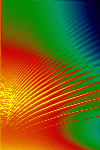
An MDI Medium-l Power Spectrum
(l-nu Diagram)The Sun resonates like a huge musical instrument. The pitch of the resonance depends on the physical conditions in the interior of the Sun where the sound waves travel. The path the sound waves take also determines the spatial pattern the resonant modes of oscillation display at the solar surface.
The figure shows how much acoustic energy there is at each frequency for every one of the spatial modes of oscillation. Unlike a musical instrument that is tuned to a single frequency and a few harmonious overtones, the Sun resonates in tens of millions of ways all at the same time. The frequency, often called nu, of each mode reveals something about a slightly different part of the Sun's interior. The spatial modes are identified from patterns on the dopplergrams that are made each minute.
The frequencies are very low compared to sound waves we are used to hearing. Most of the power (shown in yellow) is concentrated in a band near 3 mHz, that's one oscillation every 5 minutes. Sound waves we can hear vibrate from tens to thousands of times per second. Modes with higher frequencies aren't trapped inside the Sun, so they don't resonate. Modes with lower frequencies are so quiet it is hard to pick them out of the background noise.
The spatial scale of the modes is indicated by the angular degree, l, and tells how many node lines there are in the pattern at the surface of the Sun. The l=0 modes are 'breathing' modes where the whole surface of the Sun moves in and out at the same time. Higher order modes divide the surface into a pattern like a checker board, where adjacent squares move in different directions at any give time. The higher the degree the smaller the spatial scale. The modes are described by mathematical funcations called spherical harmonics. A mode of a particular degree, l, at the surface can be associated with resonances having any number of nodes in the radial direction inside the Sun. The number of radial nodes is called the order. The curved lines in the figure are associated with different radial orders. For a given order (line) the frequency decreases with increasing spatial degree. For a give degree, the frequency increases with order. In the figure, the lower left corner is most closely related to what is happening in the core of the Sun. Moving up in frequency or degree tells more about what is happening near the surface.
Each of the lines is fairly broad. That's because sound waves of a particular degree can travel in different directions. Actually there are 2*l + 1 modes for each angular degree (and each order) corresponding to slightly different directions of travel. [For examples, that would be 301 modes for l=150 on each line.] If the material through which any of these modes is traveling is moving, that affects the measured frequency of the mode. The rotation of the Sun causes the biggest frequency shift and makes the lines shown in the figure broad. Other motions within the Sun along the path taken by the waves cause different types of frequency changes. Analysis of these frequency changes reveals the internal motions of the Sun.
The faint line at lowest frequency is actually a different kind of wave, very much like ocean waves. It tells only about what is happening at the surface of the Sun.